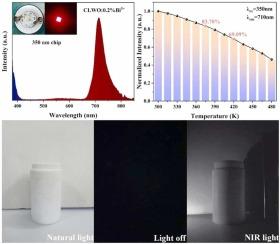间隙氧缺陷诱导Ca3La2W2O12荧光粉近红外发光
IF 6.3
2区 材料科学
Q2 CHEMISTRY, PHYSICAL
引用次数: 0
摘要
自激活近红外(NIR)荧光粉由于其无毒、廉价和不掺杂发光中心离子等优点,近年来在特殊照明和生物医学领域得到了广泛的关注。然而,高光致发光量子产率(PLQY)和热稳定性仍然是nir发光荧光粉面临的挑战。在本研究中,一种自激活荧光粉Ca3La2W2O12 (CLWO)成功地实现了近红外发射和高热稳定性。在350 nm激发下,最佳CLWO:0.2%Bi3+荧光粉的窄带发射范围为650 ~ 800 nm,半峰全宽为36 nm。机理研究表明,CLWO宿主体内的间隙氧可以作为发光中心,在近红外波段实现自激活发射。此外,CLWO:0.2%Bi3+荧光粉具有48.84%的高PLQY和优异的热稳定性(I420 K/I300 K = 69.09%)。在350 nm的LED芯片上制备了基于Ca3La2W2O12:Bi3+ (CLWO:Bi3+)荧光粉的近红外磷光转换LED (pc-LED),展示了其在近红外夜视监控方面的潜力。这项工作无疑为自激活荧光粉出色的热稳定性设计了新的见解,并为自激活近红外LED光源的应用开辟了新的研究途径。本文章由计算机程序翻译,如有差异,请以英文原文为准。

Interstitial Oxygen Defect Inducing Near-Infrared Luminescence in Ca3La2W2O12 Phosphor
Self-activated near-infrared (NIR) phosphors have recently gained extensive attention in special illumination and biomedical applications owing to its non-toxicity, inexpensiveness and especially undoped luminescence center ions. However, high photoluminescence quantum yields (PLQY) and thermal stability remain challenges for NIR-emitting phosphors. In this study, a self-activated phosphor Ca3La2W2O12 (CLWO) successfully achieved a NIR emission and high thermal stability. Under 350 nm excitation, the optimal CLWO:0.2%Bi3+ phosphor shows a narrowband emission in the range of 650-800 nm and a full width of half maximum (FWHM) of 36 nm. Mechanism studies demonstrate that the interstitial oxygen within CLWO host can work as the luminescence center, and enables self-activated emission in NIR waveband. Moreover, CLWO:0.2%Bi3+ phosphor shows a high PLQY of 48.84% and excellent thermal stability (I420 K/I300 K = 69.09%). A NIR phosphor-converted LED (pc-LED) based on a Ca3La2W2O12:Bi3+ (CLWO:Bi3+) phosphor is fabricated on a 350 nm LED chip, demonstrating its potential in NIR night-vision monitoring. This work certainly designs novel insights for outstanding thermal stability of self-activated phosphors and develops new research avenues for self-activated NIR LED light sources applications.
求助全文
通过发布文献求助,成功后即可免费获取论文全文。
去求助
来源期刊

Journal of Alloys and Compounds
工程技术-材料科学:综合
CiteScore
11.10
自引率
14.50%
发文量
5146
审稿时长
67 days
期刊介绍:
The Journal of Alloys and Compounds is intended to serve as an international medium for the publication of work on solid materials comprising compounds as well as alloys. Its great strength lies in the diversity of discipline which it encompasses, drawing together results from materials science, solid-state chemistry and physics.
 求助内容:
求助内容: 应助结果提醒方式:
应助结果提醒方式:


